The capacity of optical fiber is extremely large, and the traditional optical fiber communication system is in fiber optic transmission of optical signals, this method is actually only a small part of the fiber-rich bandwidth. In order to make full use of the huge bandwidth resources of the optical fiber and increase the transmission capacity of optical fiber, a new generation of optical fiber communication technology based on dense WDM (DWDM) technology has been produced.
Wavelength Division Multiplexer (WDM )
Wavelength Division Multiplexer (WDM) is a technology for transmitting multi-wavelength optical signals simultaneously on a single optical fiber. The wavelengths of these optical signals carry Digital signals can be the same rate, the same data format, or it can be different rates, different data formats. By adding new wavelength characteristics, according to the user’s request to determine the network capacity. For WDM at rates below 25Gb / s, current technologies can completely overcome the limitations imposed by fiber dispersion and fiber nonlinear effects to meet the various requirements for transmission capacity and transmission distance.
WDM enables bidirectional communication and a cost-efficient upgrade of capacity in optical networks.

Wavelength Division multiplexer can be divided into wavelength division multiplexer at the transmitter end and Wavelength Division Multiplexer at the receiving end. An optical multiplexer is used for the transmitting end of the transmission system and is a device having a plurality of input ports and an output port. Each of its input ports inputs a light signal of a preselected wavelength. The inputted light waves of different wavelengths are output from the same output port. The optical splitter is used at the receiving end of the transmission system, just opposite the optical combiner, which has an input port and a plurality of output ports that classify a plurality of different wavelength signals.
Multiplexer (MUX) and Demultiplexer (DEMUX)
WDM optical networks need a multiplexer (MUX) and a demultiplexer (DEMUX) to combine and split the multi-wavelength optical signals. The MUX is used to join signals together at the transmitter, while the DEMUX is used to split signals apart at the receiver.

And Multiplexers are classified into four types: 2-1 multiplexer ( 1select line), 4-1 multiplexer (2 select lines), 8-1 multiplexer(3 select lines), and16-1 multiplexer (4 select lines)
While Demultiplexer referred to as “DEMUX” is totally the opposite of Mux. It’s also a device but with one input and multiple outputs. It is used to send a signal to one of the many devices. Demux is the reverse of the MUX process – combining multiple unrelated analogs or digital signal streams into one signal over a single shared medium.
Also, Demultiplexers are classified into four types: 1-2 demultiplexer (1 select line), 1-4 demultiplexer (2 select lines), 1-8 demultiplexer (3 select lines), and 1-16 demultiplexer (4 select lines)
The general difference between mux/demux and analog switch is: mux is a signal selector, allowing you to route the signal from N inputs to 1 output. Demux will do the opposite, routing signal to one of the N outputs.
Generally, multiplexers and demultiplexers are used together. The communication system requires both multiplexer and demultiplexer due to its bidirectional nature but the operation of the two is exactly opposite to each other. The presence of control signals plays a crucial role in the working of MUX and DEMUX.
Coarse Wavelength Division Multiplexing (CWDM) and Dense Wavelength Division Multiplexing (DWDM)
The two key WDM technologies are coarse wavelength division multiplexing (CWDM), and dense wavelength division multiplexing (DWDM).

CWDM systems typically provide 8 wavelengths, separated by 20nm, from 1470nm to 1610nm. In order to increase the number of wavelengths, one can also use the 1310nm window so the CWDM channels can be increased to 16. The number of channels is fewer than in DWDM but more than in standard WDM.
DWDM packing WDM channels denser than in the CWDM system, it can go up to 80 or even 160 channels/wavelengths, with no more than 0.4nm spacing, roughly over the C-band range of wavelengths. It supports much more wavelengths than that of CWDM MUX DEMUX. DWDM’s tighter wavelength spacing fits more channels onto a single fiber, but cost more to implement and operate.
CWDM spectrum supports data transport rates of up to 4.25Gbps while DWDM is utilized more for large capacity data transport needs of up to 100Gbps. By mapping DWDM channels within the CWDM wavelength spectrum, much higher data transport capacity on the same fiber optic cable can be achieved without any need for changing the existing fiber infrastructure between the network sites. By utilizing CWDM and DWDM network systems or the mixture of them, carriers and enterprises are able to transport service from 2Mbps up to 200Gbps of data.
In the WDM (wavelength-division multiplexing) system, CWDM and DWDM Mux/Demux modules are often deployed to join multiple wavelengths onto a single fiber. A multiplexer is for combining signals together, while a demultiplexer is for splitting signals apart.
CWDM networks use CWDM modules such as CWDM MUX/DEMUX and CWDM OADM. DWDM networks use DWDM modules such as DWDM MUX/DEMUX and DWDM OADM.
The CWDM Mux Demux is a key component for the CWDM system, provide a flexible and cost-effective solution for increasing fiber capacity over single fiber networks. It commonly offers 4, 8, and 16 channel modules for metro and access network deployment

The features of CWDM mux Demux products:
1. Low Insertion Loss
2. Low PDL
3. High channel Isolation
4. Excellent Environment Reliability
While the DWDM Mux Demux Modules are designed to multiplex multiple DWDM channels into one or two fibers, also the most reasonable solution to meet increasing desires of large data transmissions. The common configuration of DWDM mux is 4, 8, 16, and 32 channels.

The features of DWDM Mux Demux products:
1.Low insertion loss and high isolation.
2. Simple to install requires no configuration and disassembles easily to clean.
3.Fully transparent at all data rates and protocols.
4.Completely passive, no power required, no cooling, and so on.
Summary:
It is foreseeable that in the all-optical network that is expected to be realized in the future, up / down and cross-connection of various telecommunication services are realized by changing and adjusting the wavelength of the optical signal on the optical. Therefore, WDM technology will be one of the key technologies for realizing the all-optical network. Moreover, the WDM system is compatible with the future all-optical network and may in the future realize the transparent and highly survivable system based on the already-built WDM system Optical Network.
The working principle of single-fiber CWDM and single fiber DWDM:

The light emitted by the 1270nm optical module is received by the 1470nm optical module, and the light emitted by the 1470nm optical module is received by the 1270nm optical module. This design allows the 1270nm optical module to communicate with the 1470nm optical module. In turn, 1290nm optical module and 1490nm optical module, 1310nm optical module and 1510nm optical module, 1330nm optical module, and 1530nm optical module, 1350nm optical module and 1550nm optical module, etc., are used in pairs.
Related Products:
-
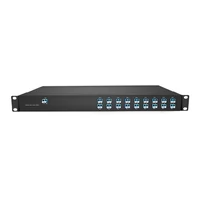 Passive CWDM Double Fiber Mux & Demux Module 18 CH (1270-1610nm) LC/UPC 1U Rack
$630.00
Passive CWDM Double Fiber Mux & Demux Module 18 CH (1270-1610nm) LC/UPC 1U Rack
$630.00
-
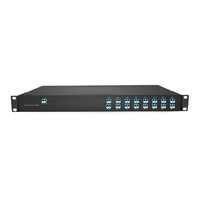 Passive CWDM Double Fiber Mux & Demux Module 16 CH (1310-1610nm) 1U Rack
$570.00
Passive CWDM Double Fiber Mux & Demux Module 16 CH (1310-1610nm) 1U Rack
$570.00
-
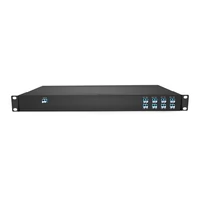 CWDM MUX 8CH 16 Wavelengths (TX: 1310/1330/1390/1410/1470/1490/1550/1570nm RX: 1350/1370/1430/1450/1510/1530/1590/1610nm) LC/UPC Single Fiber 1U Rack
$320.00
CWDM MUX 8CH 16 Wavelengths (TX: 1310/1330/1390/1410/1470/1490/1550/1570nm RX: 1350/1370/1430/1450/1510/1530/1590/1610nm) LC/UPC Single Fiber 1U Rack
$320.00
-
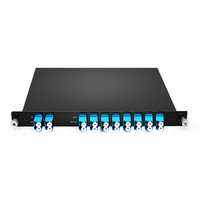 Passive CWDM Double Fiber Mux & Demux Module 8CH (1470-1610nm) & Additional 1310 Window LC/UPC LGX BOX
$310.00
Passive CWDM Double Fiber Mux & Demux Module 8CH (1470-1610nm) & Additional 1310 Window LC/UPC LGX BOX
$310.00
-
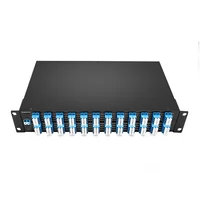 DWDM MUX DEMUX 50GHZ 96CH (C15-C62) LC/UPC Dual Fiber 2U Rack
$6000.00
DWDM MUX DEMUX 50GHZ 96CH (C15-C62) LC/UPC Dual Fiber 2U Rack
$6000.00
-
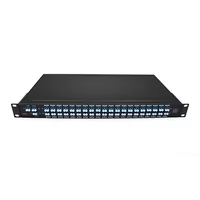 DWDM MUX DEMUX 40CH (C21-C60) LC/UPC Dual Fiber 1U Rack
$1100.00
DWDM MUX DEMUX 40CH (C21-C60) LC/UPC Dual Fiber 1U Rack
$1100.00
-
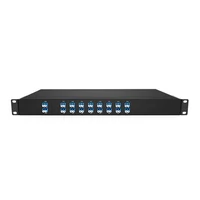 DWDM MUX DEMUX 16CH (CXX-CXX) with Monitor Port LC/UPC Dual Fiber 1U Rack
$800.00
DWDM MUX DEMUX 16CH (CXX-CXX) with Monitor Port LC/UPC Dual Fiber 1U Rack
$800.00
-
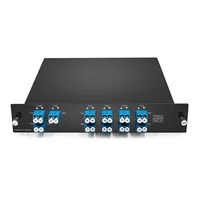 DWDM MUX DEMUX 8CH (C21-C28) with Express Port LC/UPC Dual Fiber LGX BOX
$500.00
DWDM MUX DEMUX 8CH (C21-C28) with Express Port LC/UPC Dual Fiber LGX BOX
$500.00
